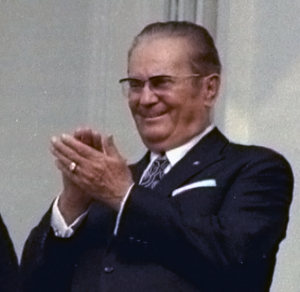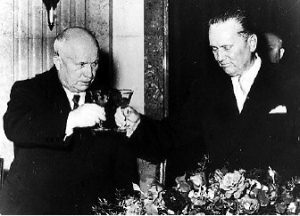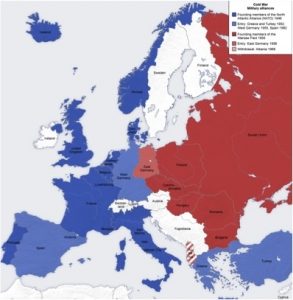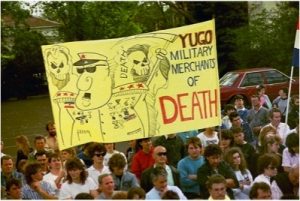Background: Tito’s Yugoslavia
BACKGROUND: TITO’S YUGOSLAVIA
This module provides a brief historical analysis of Yugoslavia, the key role it played as a buffer zone between the West and East during the Cold War and the consequences of this for domestic politics in Yugoslavia. Under the leadership of Josip Broz Tito, who ruled from 1945 until his death in 1980, Yugoslavia’s unique geopolitical situation allowed the socialist country to maintain internal cohesion while suppressing nationalistic movements within its constituting six republics (Bosnia and Herzegovina, Croatia, Macedonia, Montenegro, Slovenia, and Serbia) and two autonomous provinces (Kosovo and Vojvodina).

Yugoslavia’s contribution to the Cold War stability is well known. The role that the geopolitical environment played for the cohesion of this multiethnic country however is less well understood. This can be partly explained by Tito’s ability to convince outsiders that he had effectively resolved the interethnic tensions in his country (Stojanovic, 1997). The rhetoric of this highly respected leader about the creation of a supranational Yugoslav identity through “Brotherhood and Unity” was all too readily accepted by the eager western scholars who saw socialist Yugoslavia as a prosperous state and as an antidote to the “evil” Soviet empire. It is precisely because of this tendency that so many Westerners were caught off guard by the violent breakdown of this country. To understand the symbiotic relationship between the Cold War stability and the internal stability of Yugoslavia, this module analyzes the opportunities that this regional stability provided for Yugoslavia.
Specifically, it discusses how Yugoslavia’s position in the Cold War establishment provided it the indispensable balance to maintain its internal cohesion and suppress nationalistic, and, at times, separatist attempts by the constituting nationalities. It also discusses how the prestige Tito’s Yugoslavia enjoyed enabled its leader to borrow extensively from the West and keep the economic problems of the country under check for decades. Yet, it was precisely this privilege that doomed the country once Yugoslavia lost its geopolitical significance, and the West stopped financing its deficits. The discussion then shifts to the rapidly changing international environment of late 80s and the early 90s when Yugoslavia lost its geostrategic importance. The deep economic crisis, greatly exacerbated by the insurmountable foreign debt, accelerated the long-silenced centrifugal forces in the country, and put an end to the Yugoslav state.
Although very skeptical in the beginning, the West grew accustomed to the fact that Tito was not merely a Trojan horse of the Soviet Union in Europe and started to believe that Yugoslavia could become a strategic partner in southeastern Europe (Pribicevic, 1995; Bert, 1997). Tito’s courageous defiance of Stalin and the creation of the consequent Yugoslav type of socialism yielded him significant credibility in the eyes of the Westerners. With the death of Stalin and Khrushchev’s repudiation of Stalinism, Tito officially won his moral battle against the USSR.

This became even more dramatic as Khrushchev came to visit Yugoslavia on May 13, 1955 and approached the Yugoslav leadership with conciliatory rhetoric. While this move led to some easing of the bilateral tensions between Yugoslavia and the USSR, the Soviets were told clearly that Yugoslavia and its people had no intention of joining the Warsaw Pact. This in turn, further convinced the West that Tito’s legitimacy among his people was enormous and that Yugoslavia could play an indispensable role in Europe.
Yugoslavia’s geographic location was another reason for this conviction. This country was located in the strategic Balkan Peninsula and prevented USSR from reaching the Mediterranean. Having played an important role in the past, Yugoslavia’s location now grew to play an even more important role as it was effectively serving as a buffer zone between the two blocks (Pribicevic, 1995). Yugoslavia was not under Moscow’s direct control, and its foreign policies actually contradicted Moscow’s interests. Tito realized the importance of his country and was able to maintain a balanced, although at times fluctuating, position between the two blocks. Officially independent and neutral, Tito’s Yugoslavia had the political space to maneuver and play both competing sides. More importantly, Yugoslavia’s identity was constructed against the background of this fierce competition and Tito was able quell domestic ferment by referring to the external threat coming mostly from the Soviets.

The early strategy that Tito employed in assuaging the ethnic struggles was to mythologize the fact that every ethnic group had contributed to the liberation war against the fascists during the World War II, while hiding other historical facts that pointed to the involvement of certain groups, especially the Croats with the Axis’ side. Nonetheless, the new enthusiasm that followed the end of World War II faded as time passed, and Tito’s myth of a unified Yugoslavia became less appealing. Although important, the epic struggle of the partisans was already seen as history, and the new generation together with the disillusioned communists became increasingly more demanding of reforms. These reforms were most often advocated along ethnic lines. By 1960s, for example, many intellectual groups operating within Croatia were voicing their opposition to the federal government in the media (Lane, 2004).

The fall of Rankovic, the head of the secret service, in the summer of 1966 eased the terror that the Yugoslav secret security (UDBA) had created in peoples’ minds. Consequently, opposition voices were becoming increasingly loud. Student organizations such as Croatia’s Praxis, intellectuals and members of the League of Communists of Yugoslavia started working more diligently towards criticizing the centralization of the country and the federal economic and cultural policies (Lane, 2004). Encouraged by the events of the Prague Spring, 130 Croat intellectuals prepared a declaration and presented it to the local communist authorities. They requested the official recognition of a separate Croatian language in places where Croats lived (Lane, 2004). The movement, however, was not only confined to linguistic and cultural reforms, it also targeted the federalist and centralized nature of the country. Croats were unhappy to see that 80 percent of the country’s trade was conducted through its major ports and that large amounts of hard currency earned from tourism opportunities in this region was spread out mainly across the poorer regions of the country (Lane, 2004; Woodward, 1995). They saw the centralist nature of the state, as the main impediment to Croatia’s further development and achievement of higher living standard, comparable to those in Western Europe.

As Lane (2004) argues, the opposition led by both the communists and the intellectuals “took on nationalistic undertones that surfaced periodically to threaten the unity of the Yugoslav state and ultimately overwhelm it” (P. 136). All this amounted to what is often referred as the Croatian Spring, a period of student protests, inflammatory nationalistic rhetoric and general political crisis in the country. For the first time Tito and his closest collaborators realized the real danger the renewed Croatian nationalism posed for the stability and unity of Yugoslavia. It was then that Tito decided to purge the deviating communists in Croatia and put an end to the flourishing public debate, which for some time had been left unchecked (Lane, 2004).
The international arena played an indispensable role in keeping the ethnic discontent limited, as it did in many other occasions when there was social unrest and inter-ethnic tensions in Yugoslavia. The tumultuous times of the late 1960s, culminating with the Soviet invasion of Czechoslovakia, enabled Tito to use one of his strongest tools in maintaining internal cohesion: the external threat. Tito effectively mobilized the entire eligible population, both men and women, and made small army units ready for an armed invasion from the Soviets. The threat was credible and further helped Tito demobilize the nationalist leaders in both Croatia and Serbia proper (Lane, 2004). In Lane’s (2004) words, “[u]sing the old bogey of the security threat to Yugoslavia’s independence posed by Soviet aggression, Tito manipulated the occasion in such a way as to assist in the task of quelling domestic unease” (P. 139).
This last point is essential to understanding the internal stability of Yugoslavia during the Cold War period. The Yugoslav people were prone to believe that, despite the many problems that existed in the country, a potential weakening of the state, which might invite a Soviet invasion, could have far more debilitating effects on their particular regions. The intimidating Soviet army, and the exaggerated threat it posed, allowed Tito to dissuade regional leaders from pushing for major reforms along nationalistic lines. The sense of a common destiny reinforced by a sense of a common peril deterred the nationalistic leaders from pushing too far. Recently declassified CIA documents from the Cold War era confirm this conclusion as they emphasize the effectiveness of Tito’s strategy of using external threat, mainly that of the Soviets, as a strong political tool for keeping domestic affairs in order.
It is important to note that, after the alarming crisis of the 1960s had been partially resolved, Tito and his cabinet produced a new constitution for Yugoslavia in order to satisfy some of the reformists’ demands. Being the fourth constitution produced in less than thirty years, this one made extensive provisions for local self-management to the six republics. It also granted Kosovo the status of a province (Woodward, 1995). Many saw the new constitution as Tito’s last attempt to satisfy all the nationalities (Stojanovic, 1997). The content of this constitution made Yugoslavia a defunct confederation of six republics and two provinces unified by the effect of the external threat posed by the Soviet Union and its satellite protégés in Europe (Woodward, 1995; Lane, 2004, Gagnon, 2004).

For example, the U.S. controlled International Monetary Fund and the World Bank were more than happy to assist Yugoslavia with extremely favorable loans, in its modernization. With the help of these funds, for a few decades Yugoslavia was able to invest in the newest technologies coming from Western Europe and to improve its competitive advantage in certain sectors of the economy (Lane, 2004). The borrowing had the desired effect in the short run, as it ameliorated the internal economic crisis, which was deepening by the time the oil shock occurred in 1973 due to wrong economic policies, ineffective bureaucracy, and decreasing firm productivity (Woodward, 1995). However, the borrowing had devastating long-term economic effects and their political consequences are discussed in the next section.
It should be noted that the Soviets agreed with the balance of power Yugoslavia provided, and were very reluctant to provoke a military clash with the U.S. by trying to forcefully control the former. The US had made it clear in few occasions after the invasion of Czechoslovakia in 1968 that it would not tolerate further Soveit aggression against any neutral country in Europe (Woodward, 1995; Ullman, 1996; Pribicevic, 1995). Granting that the reasons for the Western support were multidimensional and played many functions, the West tried to discourage Yugoslavia with its generous financial and other forms of aid, from aligning to closely with the ideologically similar superpower: the Soviet Union. The Soviets, on the other hand, unwilling to risk a potential world-war, were satisfied to keep Yugoslavia from deviating too much from its “socialist” course and join NATO, which would have significantly tipped the Cold war balance of power (Ullman, 1996).
The crisis was further deepened because the republics, after gaining significant control over their regions from the 1974 constitution, had borrowed individually and uncontrollably from abroad (Woodward, 1995). From the total amount borrowed, only 35 percent was borrowed by the central government, whereas the six republics and the two autonomous provinces had borrowed the remaining 65 percent. Oftentimes, the central government was not aware of the borrowing spree happening at lower levels of government (Bennett, 1995).
When the central authorities made serious efforts to tackle this problem, they noticed that the debt had increased to unprecedented amounts. One of the effects of this crisis was that the richer republics of Slovenia and Croatia, due to the disproportionate contributions they were obliged to make for servicing the debt, became increasingly nationalistic and refused to continue doing so. As the gap between the richer and poorer regions increased, richer ones also refused to make transfers to the poorer republics and provinces (Kovac, 1995). By the end of the 1980s, the economic crisis had become so serious that living standards had fallen by over 40 percent and, at one point in 1989, inflation reached 2000 percent (Bennet, 1995). This further fueled ethnic divisions and finger pointing.
In a nutshell, the cheap loans that Tito provided for Yugoslavia, because of his politics of neutrality, helped ameliorate the domestic interethnic tensions, but the failure of repaying them assumed dramatic dimensions during the 1980s. Powerful nationalist and chauvinist forces were released during this crisis, and Yugoslavia was facing its worst political ordeal in the post-war history.
During these changes in Europe, Yugoslavia could not count on the two greatest contributors to its internal stability: the external threat and the financial support of the U.S. “As a result of these developments” Bennet (1995) argues, “Yugoslavia lost one of the most important credentials it had to justify its specific international position, as a buffer zone between the two blocks” (P. 341). The U.S. clearly shifted its interest away from the region, and it was happy to pass its watchdog role to the European Union. The EU’s unpreparedness seems to have made things worse (Stojanovic, 1997). The EU’s strategy was non-existent or at best confused, and particular EU member states, most notably Germany, were giving signals to Yugoslavia that were actually encouraging a break-up (Woodward, 1995). During the summer of 1991, both Croatia and Slovenia declared their independence. Macedonia followed few months later, and finally Bosnia did the same. This put an end to Yugoslavia and marked the beginning of the worst bloodshed in post-World War II Europe.
References
Bennett, C. (1995). Yugoslavia’s bloody collapse: causes, course and consequences. New York : New York University Press.
Bert, W. (1997). The reluctant superpower: United States’ policy in Bosnia, 1991-95. New York : St. Martin’s Press.
Crnobrnja, M. (1996). The Yugoslav drama. Montreal: McGill-Queen’s University Press.
Dunay, P. (1992). Stability in East Central Europe. Journal of Peace Research, Vol. 29, No. 1. (Feb., 1992), pp. 1-6.
Gagnon, Jr. V.P. (2004). The myth of ethnic war: Serbia and Croatia in the 1990s. Ithaca, N.Y.: Cornell University Press
Kovac, O. (1995). Foreign economic relations. In Ramet, S.P. and Adamovic, L. (Ed.), Beyond Yugoslavia: politics, economics, and culture in a shattered community (P.281-300). Colorado: Westview Press
Lampe, J. R. Prickett, R.O., Adamovic, L. (1990) Yugoslav-American economic relations since World War. Durham: Duke University Press
Lane, A. (2004). Yugoslavia: When ideals collide. New York: Palgrave Macmillan
Pribicevic, B. (1995). Relations with the superpowers In Ramet, S.P. and Adamovic, L. (Ed.), Beyond Yugoslavia : politics, economics, and culture in a shattered community (P.331-349). Colorado: Westview Press
Rothschild, J. (2000). Return to Diversity. New York: Oxford University Press.
Stojanović, S. (1997). The fall of Yugoslavia: Why communism failed. Amherst, N.Y.: Prometheus Books.
Tepavac, M., (2000). The interlude: 1980-1990. In Jasminka Udovički & James Ridgeway (Ed.), Burn this house: the making and unmaking of Yugoslavia (P.64-79) Durham: Duke University Press.
Ullman, R.H. (1996). The world and Yugoslavia’s Wars. New York: Council on Foreign Relations.
Woodward, S. L. (1995). Balkan tragedy: chaos and dissolution after the Cold War. Washington, D.C.: Brookings Institution.
Zimmermann, W. (1996). Origins of a catastrophe: Yugoslavia and its destroyers — America’s last ambassador tells what happened and why. New York: Times Books.
